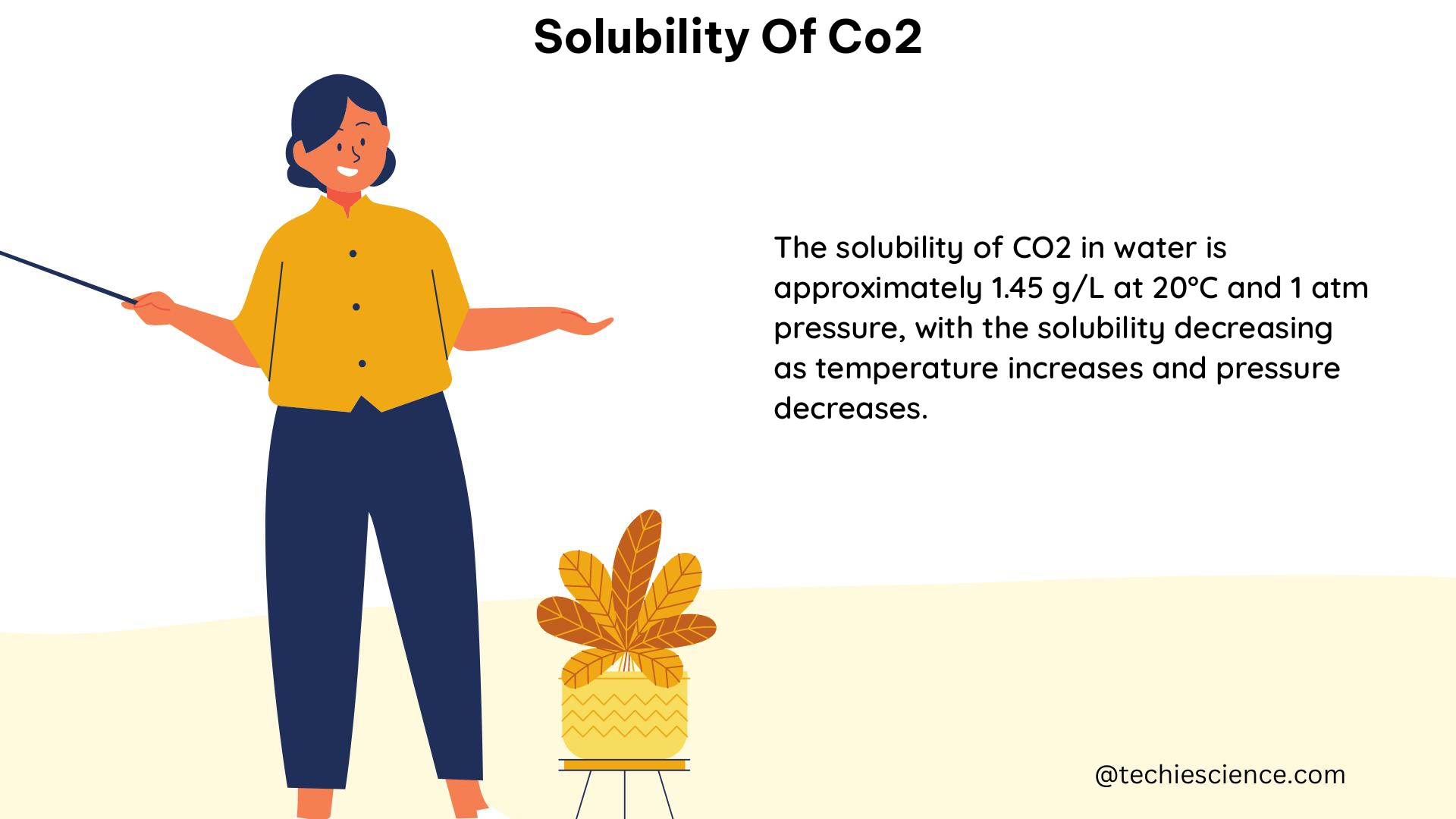The solubility of carbon dioxide (CO2) in water is a crucial property that has far-reaching implications in various scientific fields, including chemistry, biology, and environmental science. This comprehensive guide delves into the technical details and practical aspects of understanding and measuring the solubility of CO2 in water.
Understanding the Solubility of CO2 in Water
The solubility of CO2 in water is influenced by several factors, including temperature, pressure, and the presence of other substances in the water. These factors can significantly impact the amount of CO2 that can dissolve in water, and understanding these relationships is essential for accurate predictions and applications.
Temperature and Solubility
The solubility of CO2 in water is inversely proportional to temperature. As the temperature increases, the solubility of CO2 in water decreases. This relationship can be described by the following equation:
S = kH * P
Where:
– S is the solubility of CO2 in water (mol/kg)
– kH is the Henry’s law constant (mol/kg/bar)
– P is the partial pressure of CO2 above the water (bar)
The Henry’s law constant (kH) for CO2 in water at a temperature of 310.15 K (37°C) is 0.025 mol/kg/bar. This means that at a temperature of 37°C and a partial pressure of 1 bar, the solubility of CO2 in water is approximately 0.025 mol/kg.
Pressure and Solubility
According to Henry’s law, the solubility of a gas in a liquid is proportional to the partial pressure of the gas above the liquid. This relationship can be expressed as:
S = kH * P
Where:
– S is the solubility of CO2 in water (mol/kg)
– kH is the Henry’s law constant (mol/kg/bar)
– P is the partial pressure of CO2 above the water (bar)
This means that as the partial pressure of CO2 increases, the solubility of CO2 in water also increases linearly.
Presence of Other Substances
The presence of other substances in the water, such as salts, can also affect the solubility of CO2. Studies have shown that the solubility of CO2 in solutions of NaCl, CaCl2, and MgCl2 decreases as the concentration of the salt increases.
Measuring the Solubility of CO2 in Water

Measuring the solubility of CO2 in water can be done through experimental methods and calculations using equations such as Henry’s law. Here’s a step-by-step guide on how to measure the solubility of CO2 in water:
- Prepare a sample: Prepare a sample of the water or other substance in a container.
- Add CO2: Add a known amount of CO2 to the container.
- Measure partial pressure: Measure the partial pressure of CO2 above the substance.
- Measure dissolved CO2: Measure the amount of CO2 that has dissolved in the substance.
- Calculate solubility: Calculate the solubility of CO2 in the substance using Henry’s law.
The solubility of CO2 in water can be calculated using the following equation:
S = kH * P
Where:
– S is the solubility of CO2 in water (mol/kg)
– kH is the Henry’s law constant (mol/kg/bar)
– P is the partial pressure of CO2 above the water (bar)
By measuring the partial pressure of CO2 and using the known Henry’s law constant, you can calculate the solubility of CO2 in the water sample.
Practical Applications of CO2 Solubility
The solubility of CO2 in water has numerous practical applications in various fields, including:
-
Environmental Science: Understanding the solubility of CO2 in water is crucial for studying the carbon cycle, ocean acidification, and the effects of CO2 emissions on aquatic ecosystems.
-
Chemical Engineering: The solubility of CO2 is important in processes such as carbon capture and storage, where CO2 is dissolved in water or other solvents for sequestration or utilization.
-
Biological Systems: The solubility of CO2 in blood plays a vital role in the transport and exchange of CO2 in the human body, which is essential for respiration and other physiological processes.
-
Industrial Processes: The solubility of CO2 is important in industries such as food and beverage production, where CO2 is used as a preservative or carbonating agent.
By understanding the technical details and practical applications of CO2 solubility, researchers, engineers, and scientists can make informed decisions and develop effective solutions in their respective fields.
Conclusion
The solubility of carbon dioxide (CO2) in water is a complex and multifaceted property that is influenced by various factors, including temperature, pressure, and the presence of other substances. By understanding the technical specifications and practical applications of CO2 solubility, researchers and professionals can better navigate the challenges and opportunities in their respective fields.
References:
- The Solubility of Carbon Dioxide in Water at Low Pressure. (n.d.). Retrieved from https://srd.nist.gov/JPCRD/jpcrd427.pdf
- Suitable CO2 Solubility Models for Determination of the CO2 Removal Rates in a Blood Tubing System. (2021). Retrieved from https://www.ncbi.nlm.nih.gov/pmc/articles/PMC8000709/
- Measurement of Solubility of CO2 in NaCl, CaCl2, MgCl2 Aqueous Solutions and Synthetic Brines. (2021). Retrieved from https://www.mdpi.com/1996-1073/14/21/7222

The lambdageeks.com Core SME Team is a group of experienced subject matter experts from diverse scientific and technical fields including Physics, Chemistry, Technology,Electronics & Electrical Engineering, Automotive, Mechanical Engineering. Our team collaborates to create high-quality, well-researched articles on a wide range of science and technology topics for the lambdageeks.com website.
All Our Senior SME are having more than 7 Years of experience in the respective fields . They are either Working Industry Professionals or assocaited With different Universities. Refer Our Authors Page to get to know About our Core SMEs.